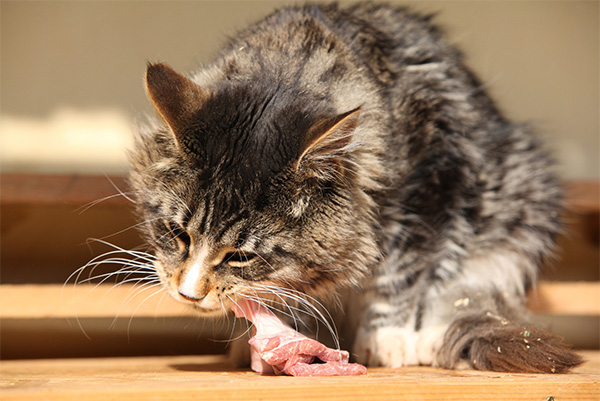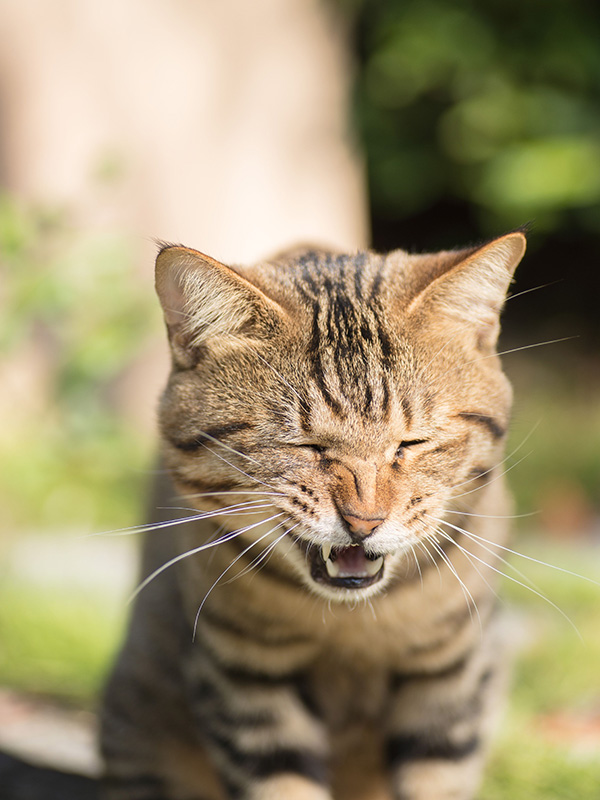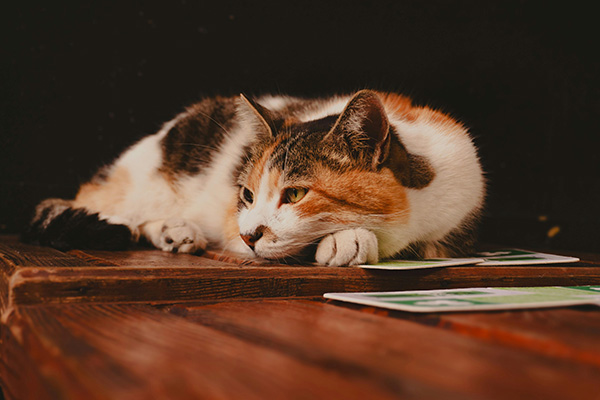As a devoted cat owner, it can be concerning to see your feline friend experience vomiting after meals. Cats are generally independent creatures that don’t complain much, so when they throw up, it catches our attention. Understanding why your cat vomits after eating involves exploring various reasons, ranging from benign to serious ones. Let's take a closer look at possible causes of why your cat is throwing up and how you can address it. If you are worried about your cat's health, contacting your vet immediately is best.
Understanding Cat Vomiting: Normal vs. Concerning
Cat throwing up can sometimes be normal, but knowing when it might signal a health issue is important. Occasional vomiting due to hairballs is common, especially in long-haired breeds. Cats groom themselves regularly and may swallow hair, leading to hairball formation, which they expel through occasional vomiting. Another typical scenario is when a cat eats too quickly and regurgitates shortly after—this “scarf and barf” behavior is usually harmless if infrequent and not accompanied by other symptoms. Additionally, dietary changes can sometimes upset a cat’s stomach temporarily, causing mild vomiting that typically resolves once the system adjusts.
However, some types of vomiting are abnormal and may signal underlying health problems. Frequent or persistent vomiting (more than once a week) might suggest gastrointestinal problems, food allergies, or inflammatory bowel disease (IBD). If vomiting occurs alongside other symptoms such as lethargy, loss of appetite, diarrhea, or weight loss, it could be a sign of serious conditions like kidney or liver disease or pancreatitis. Vomiting bile (yellow or green fluid) or blood (red or brown) is also abnormal and may indicate inflammation, ulcers, or other conditions requiring veterinary attention. Sudden, severe vomiting that happens multiple times within a few hours, especially if paired with distress, dehydration, or weakness, can be an emergency, potentially caused by poisoning, an obstruction, or infection.
If your cat’s throwing up appears unusual, experiences chronic vomiting, or is accompanied by other worrying symptoms, it’s important to consult a veterinarian to rule out any serious health concerns.
Common Causes of Cat Throws Up After Eating

Eating Too Fast
When cats eat too quickly, they often swallow large amounts of food without properly chewing and excessive air. This rapid intake can overload the stomach, causing discomfort and leading to regurgitation shortly after eating. Known as "scarf and barf," this type of vomiting is typically caused by the stomach's inability to handle the sudden influx of food and air, triggering the body to expel it quickly.
In a cat’s natural behavior, hunting small prey throughout the day results in slower eating habits. However, when given food in a bowl, especially if it’s only offered once or twice a day, some cats may eat quickly due to hunger, excitement, or competition if other pets are around. The quick consumption can overstretch the stomach and stimulate the vagus nerve, which runs from the brain to the stomach and triggers cats to throw up as a reaction to the excess volume and swallowed air.
What You Can Do
Use a Puzzle Feeder: Or known as slow feeders, these feeders are created to help slow down the eating process. Your cat needs to work a bit to get the food, effectively reducing the speed at which it consumes it.
Smaller, Frequent Meals: Divide your cat’s daily food into smaller, more frequent meals to avoid the urge they might have to eat quickly all at once.
Dietary Indiscretions
Dietary indiscretions, or eating things outside a cat’s regular diet, can lead to vomiting due to the cat’s sensitive digestive system. Cats are generally creatures of habit, and their digestive systems are finely tuned to specific, consistent diets. When a cat ingests something unusual—whether it’s human food, table scraps, plants, or other non-food items—their stomach may struggle to process it, causing gastrointestinal upset and leading to vomiting.
For example, certain foods that are safe for humans, like dairy, spices, or fatty foods, can irritate a cat’s stomach, as cats lack the enzymes needed to break down these ingredients effectively. Non-food items, like string, rubber bands, or pieces of toys, can also irritate the digestive tract or cause blockages, resulting in vomiting as the body’s way of trying to expel the foreign material. Even sudden changes in their usual cat food or treats can disrupt the gut microbiome, leading to inflammation and vomiting.
What You Can Do
Cat-Proof Your Home: Keep potential hazards out of reach, including string, ribbons, and small toys.
Gradual Food Introduction: When changing your cat’s diet, introduce the new food gradually for a week or longer to ease them into the new cat food without digestive issues.
Allergies or Intolerances

Allergies or intolerances to certain foods can cause vomiting in cats as their bodies react adversely to specific ingredients. When a cat has a food allergy, their immune system misidentifies a harmless substance (often a protein source like chicken, beef, or fish) as a threat and triggers an inflammatory response. This response can affect the digestive system, leading to symptoms such as vomiting, diarrhea, and, in some cases, skin irritation or itching. On the other hand, cats with food intolerances lack the necessary enzymes to digest particular ingredients properly, which causes digestive upset without involving the immune system.
Both allergies and intolerances create inflammation in the digestive tract, making it difficult for cats to keep food down. For instance, cats with lactose intolerance lack the enzyme lactase to break down lactose in dairy products, often resulting in vomiting or diarrhea after consuming milk or cheese. Similarly, certain additives, fillers, or artificial flavors in lower-quality foods can trigger vomiting in sensitive cats.
What You Can Do
Consult Your Vet: Collaborate with your vet to pinpoint any potential food allergies and consider switching to hypoallergenic cat food. This process might involve an elimination diet.
Watch for Patterns: Keep a diary of foods and any reactions to see if there’s a consistent pattern.
Hairballs
Hairballs can lead to vomiting in cats when ingested fur collects in the stomach instead of moving through the digestive tract. Cats groom themselves regularly, swallowing loose hair in the process. While most of this hair passes through the digestive system and is eliminated in the stool, some may stay in the stomach and form a hairball over time, particularly in long-haired breeds or cats that groom excessively.
As the hairball increases in size, it can lead to discomfort and irritation in the stomach lining. In response, the cat’s body expels the hairball by inducing vomiting. Vomiting is the cat’s natural way of clearing obstructions, so if the hairball is too large to pass naturally through the intestines, the body expels it by vomiting. This process often leads to the characteristic tubular-shaped hairball, which consists of compacted fur mixed with digestive fluids and possible undigested food. While occasional hairballs are generally normal, frequent vomiting due to hairballs may indicate excessive grooming or an underlying gastrointestinal issue.
What You Can Do
Regular Brushing: Regular grooming with brushes can help reduce the amount of hair your cat swallows, which can minimize the formation of hairballs.
Hairball Control Diets: Certain cat foods are formulated to help with hairball management by improving gastrointestinal transit.
Gastrointestinal Problems

Gastrointestinal (GI) problems can cause cats to vomit due to inflammation, irritation, or disruption within the digestive system. Conditions such as gastritis, pancreatitis, inflammatory bowel disease (IBD), and food intolerances can lead to frequent or persistent vomiting as the body tries to expel substances or relieve discomfort. These issues affect the stomach and intestines, causing inflammation that disrupts the normal digestive process and often triggers vomiting as a primary symptom.
What You Can Do
Vet Check-Up: If you suspect gastrointestinal issues, don’t delay getting your cat checked by a vet. Tests may be needed to diagnose and manage such conditions.
Monitor Other Symptoms: Look for signs like diarrhea, lethargy, or weight loss that could accompany vomiting, which might indicate a serious condition.
Illness
When a cat has a bacterial or viral infection, it often causes inflammation and irritation in the digestive system, which can lead to vomiting after eating. These pathogens disrupt the normal function of the stomach and intestines, making it difficult for the cat to digest and process food properly. The inflammation caused by infections like feline panleukopenia virus or bacterial infections (such as Salmonella or Campylobacter) irritates the stomach lining, making it hypersensitive. As a result, when the cat eats, the inflamed stomach reacts by triggering vomiting, as the body struggles to tolerate the food.
What You Can Do
Consult a Veterinarian: Infections need professional assessment and treatment. A veterinarian can identify the specific infection and recommend the proper treatment, including antibiotics for bacterial infections or supportive care for viral ones.
Provide Hydration Support: Vomiting can rapidly result in dehydration, posing a serious risk to cats. Make sure your cat always has access to clean, fresh water. Your vet may also recommend electrolyte solutions or subcutaneous fluids to maintain hydration, especially if your cat is severely dehydrated or not drinking water.
Isolate from Other Pets: Some infections, like feline panleukopenia or certain bacterial infections, can be contagious. To prevent the spread of infection, isolate your cat from other pets and clean its food and water bowls, litter boxes, and bedding regularly.
